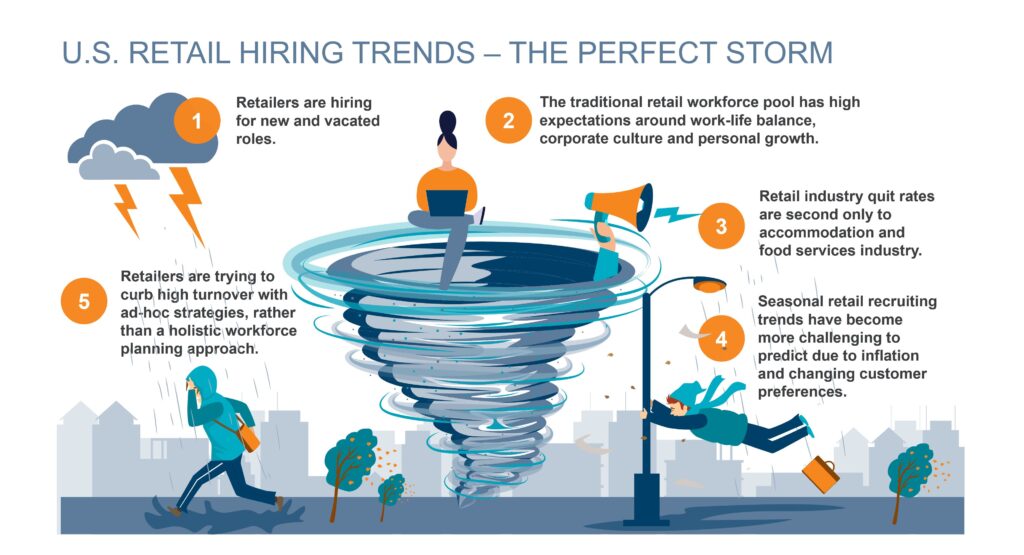The big picture: The retail industry faces a labor crisis as workers leave for better work-life balance and incentives. Data shows high quit rates and a need for industry-experienced talent in management roles.
Why it matters: The industry’s struggle to attract and retain talent is hindering growth and competition. This trend will only worsen in the coming months as competition for seasonal holiday workers heats up.
The bottom line: Filling retail jobs is a herculean task, requiring workforce planning and alternative staffing solutions.
- Retail leaders must develop a holistic strategy to attract and retain talent.
- Advanced analytics can help them make data-driven talent decisions.
- Investing in workforce redesign can lead to improved productivity, reduced costs, and better customer experience.
- Contractors and managed services agencies can provide flexibility and access to non-traditional talent pools.
Go deeper: Click here to learn why traditional ways of recruiting are not so effective in the current environment. Also, read this blog for more on how to develop a strategic workforce plan.
The retail industry continues to face a perfect storm of labor challenges postpandemic as its traditionally young talent pool exits the workforce in search of a better work-life balance, greater incentives (salary and benefits), flexibility, and a working environment that better supports their mental health and overall well-being.
High turnover is nothing new for the retail industry, but the confluence of the pandemic, economic uncertainty and the retirement of baby boomers is significantly hampering retailers’ ability to attract and retain talent. Unfortunately, this trend will only worsen in the coming months as competition for seasonal holiday workers heats up. Meanwhile, the return to the in-store shopping experience and the continued growth of the pandemic-era model of buying online and picking up in-store are expected to increase demand for more retail workers to provide quick fulfillment and delivery services.
Filling these retail jobs will be a herculean task for many organizations. Data compiled by the U.S. Chamber of Commerce show that the COVID-19 pandemic caused 47.8 million workers to quit their jobs in 2021, and an additional 50 million workers left the workforce last year. Some of these workers are returning to the job market but opting for other opportunities outside retail.
Of the industries impacted by quitting employees, the accommodation and food services industry has recorded the highest monthly quit rate of 4.9%, followed by the retail industry, which has quit rates hovering around 3.3%. Data shows that the national quit rate average for all industries was 2.6% in March 2023.
The labor crisis is hampering growth and retail companies’ ability to compete in the following areas:
- Frontline employees, who are leaving to find increased salaries and benefits and better career opportunities.
- Senior management and executive roles, where industry-experienced talent is needed to lead organizations through market challenges, including reorganization, digitalization, supply chain disruption and business-model redesign.
To address these issues effectively, retail business leaders must develop a deeper understanding of the labor dynamic and the forces driving changes across the industry. The conversation should begin in the boardrooms and executive suites, starting with these prompting questions: What do frontline employees and managers want in a job? What will motivate them to show up every day? Are traditional ways of recruiting and hiring effective in the current environment?
Beyond the discussions, companies need to consider implementing these actions:
- Develop a workforce-planning strategy to properly address short- and long-term resource needs.
- Invest in tools and analytics to enable evidence-based talent decisions.
- Consider alternative staffing solutions to combat the labor crisis.
The need for strategic workforce planning
Many retail companies are still employing the same old ad hoc or HR production-line strategies to retain and recruit talent. That mindset needs to change. Retail leaders should look to implement a holistic workforce-planning strategy starting with the employment brand and encompassing recruitment, talent marketing, talent development and management, and retention and redeployment strategies. Here are a few things to consider when developing a strategic workforce plan:
- Employment brand: Building a strong employment brand is an effective way to improve the organization’s ability to attract and retain top talent. This approach requires reassessing the organization’s reputation among current and former employees, as well as job applicants, and proactively addressing persistent concerns. The reassessment should include reviewing what employees are saying about the organization on Glassdoor and Indeed, among other employer-reputation platforms. It also means taking proactive steps to address any negative narratives, both real and perceived, on these platforms.
Also, as part of building the employment brand, retailers should put together an employment value proposition. This involves evaluating why a prospective job applicant will choose to apply for a position at your organization versus the competition. There must be something unique and compelling about your organization that drives candidates to your job site, and having a firm understanding of what that is, is crucial. Developing a value proposition and integrating that into the recruitment process can also be achieved by creating a personalized persona journey.
- Talent marketing: One way to increase the number and quality of employment candidates is to ensure that the organization is using the most effective recruiting sources and channels to find talent. For instance, some retailers have found that job boards are less effective and are opting to advertise more on social media feeds.
Regardless of the marketing channel used, the messaging needs to be effective. This means ensuring consistency in the communication and marketing plan for various stakeholders. HR leaders can team with marketing colleagues to develop creative campaigns, like video testimonials featuring current employees, which will be shared with prospective employees. These campaigns may describe what it means to work at the organization and reinforce the employment value proposition. Remember employees are your organization’s most effective brand ambassadors.
- Talent forecasting: This involves using scenario-based capabilities to develop a hiring plan that reflects short- and long-term priorities. For example, if there are plans to open a new branch location, the hiring plan should emphasize the unique aspects of that branch, which, for example, could be its convenient proximity to a transportation hub. Changes to business hours for specific retail locations or across branches could also factor into talent forecasting in terms of helping determine the number of workers to hire and the shifts available.
With better talent forecasting, HR leaders will gain a deeper understanding of job applicants and their specific needs. For example, frontline retail workers tend to be more transient, younger workers who are still in school. This means a retailer that can provide flexible working hours is ideal for this demographic. Tuition reimbursement is also an attractive benefit for these workers. Some have young families, so access to childcare services is a priority. Forecasting can help the organization understand the candidates they want to attract and their pain points — and this information will help organizations tailor recruitment efforts so they can source a stronger pool of candidates and reduce turnover rates.
Making informed decisions with talent analytic tools
Many retailers capture traditional human resource metrics like headcount, attrition and labor cost using human resources information systems (HRIS). These systems typically generate operational reports that can be used to support talent-acquisition decisions. However, advanced analytics can be deployed to help retailers make informed data-driven decisions. These newer tools combine data from different internal systems , not only HR, and reliable external sources like market trends, to enable statistical modeling, solve business problems and predict future workforce trends or issues.
Retailers can also leverage predictive analytics to determine how the workforce will develop, where leadership succession could be jeopardized and which positions are likely to open in the immediate future. They can also take advantage of innovative technology solutions — AI-driven talent-intelligence tools and workforce-planning and design software — which are hitting the market at an opportune time. These tools equip HR groups with more accurate, detailed and real-time views of all the skills that reside within the organization. (You can read more about how technology can help your organization redesign workforce planning for success here.)
Deploying alternative talent solutions
Using contractors allows companies to respond with flexibility to meet market demands, especially for projects that require specific skills or additional resources quickly. A recent Robert Half study shows half of Gen Zers who are looking for a new job in 2023 are interested in contract work, which is appealing because it provides an opportunity to take on a variety of assignments and work at different companies to build skills and connections. Third-party managed services agencies and recruiters can also help retailers find candidates outside their traditional talent pools and pipelines — such as those who are working full-time for one employer but may consider alternative options.
Key takeaways: Many of the workforce-redesign strategies discussed will require investment from the organization, which may prove to be a challenge for some smaller, cash-strapped retailers facing out-of-control inflation and increased labor costs. However, companies that can invest upfront in redesigning their employment brand and employment value proposition, as well as realign the employee experience accordingly, should see improved productivity, reduced hiring costs and greater employee engagement. Companies can also expect a meaningful return on investment associated with shorter time-to-hire, low turnover, better-qualified and more culturally fit candidates, and improved overall customer experience.







